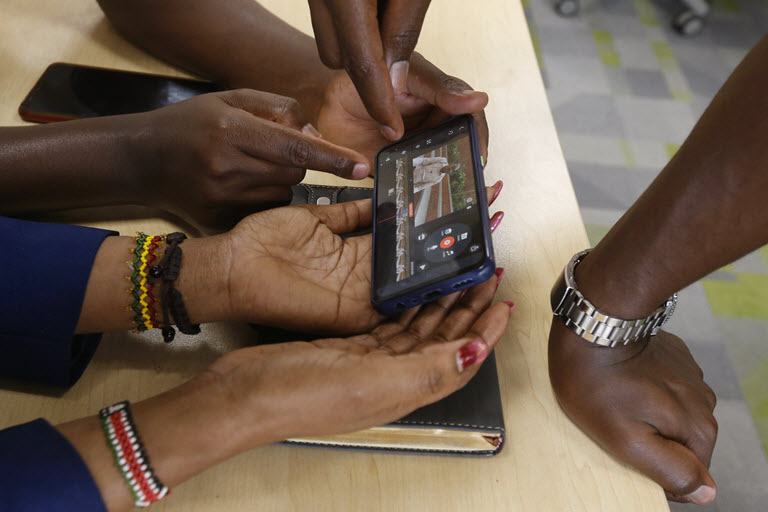To align with the changing times and stay relevant in the business, media houses are challenged to rethink their strategy and to adopt and understand obstacles and challenges they face towards rethinking and exploring alternative sources of revenue and on developing the digital strategy
In the past few years, digital transformation has disrupted almost every sector media sector included. It is almost a year now since I wrote the article, “News is No Longer News, Technology Disrupting Traditional Journalism.” showing how technology is disrupting the media sector and threatening the existence of traditional media. To help Small and Medium Media Houses (SMMH) rethink their business models and create alternative sources of revenue. DW Akademie supported Sahara Ventures to build the capacity of local media houses to rethink their business model and develop strategies to stay relevant in the current market.
Swichi Project is a project which aims at capacity building of media houses to rethink their business models. The project support media houses to develop a strategy for rethinking revenue streams and digital transformation by developing a co-creating a Do-It-Yourself Toolkit for SMMH struggling to cope with the changes.
Since the project has started, we have engaged with eight Media Houses and five Press Clubs in Mwanza, Mbeya, Shinyanga, Musoma, Dodoma, Katavi, Morogoro and Kagera. We have engaged with TVs, Radios, and blogs. Eleven media houses were identified to be the primary beneficiaries of the project. The engagement with the grassroots media houses aimed at introducing the project and co-creating with the media houses and press clubs on rethinking business models and revenue streams capitalizing on digital transformation. During the interventions, three tools are explored with line management and teams of the media houses;
The Challenge Definition Canvas
The challenge definition canvas is adopted to help media houses to understand obstacles and challenges they face towards rethinking and exploring alternative sources of revenue and on developing the digital strategy. The tool looks into; Stakeholders, Process, Infrastructure, Culture, Strategy and Data challenges media houses faces that limits them from exploring new business models.
Revenue Streams and Digital Transformation Canvas
The revenue streams and digital transformation canvas is a tool inspired by Prof. Marc Peter’s Digital Transformation Canvas to help organizations rethink and strategize for digital transformation. The RSDT Canvas is adopted to help media houses rethink specific components of their business models to help them rethink their revenue streams while at the same time reflecting on digital strategy. The tool is still a work in progress. Part of the exercise is to reflect with the media houses on improving the tool to meet their needs by adopting a user-centred approach. The tool has evolved from the first media house to the eighth.

The Use Case Canvas
To document practical cases of media houses exploring new alternative revenue stream sources, we adopted a Use Case canvas to capture a specific scenario of media houses adopting new business models or incorporating digital transformation in their strategy. The goal is to gather as many cases and stories as possible to be incorporated in the final DIY Toolkit document and Digital Platform, which is the main output of the Swichi Project.
What Have We Learned?
Engaging with grassroots media houses has helped validate our hypothesis that media houses are struggling to rethink their strategy and develop innovative and sustainable sources of revenue streams. SMMH also agreed on the challenge facing their businesses in competing with new forms of media, especially digital media platforms and the rising wave of digital journalists and influencers. Specific reasons learned;
The project is ongoing; these are some of the lessons we have learned so far from the interventions with the media houses.
What Next?
The project’s next phase is to help the media houses work on their Revenue Streams and Digital Transformation strategies. The selected media houses are currently working on their drafts based on co-created meetings we hosted with them. The tools used, lessons learned and adopting practical cases to design and create the final DIY Toolkit available online for download for the rest of the media houses to use. We will create a digital platform for users to adopt the tools.

We appreciate all the support we have received from the media houses and press clubs so far. We are looking forward to creating the DIY Toolkit for Rethink Revenue Streams and Digital Transformation.
For more details about the Swichi Project, go to this link.
This article reflects the Swichi Project implemented by Sahara Ventures in partnership with DW Akademie and Tanzania Media Foundation (TMF). It was first published on afruturist.medium.com
 Jumanne Rajabu Mtambalike
Jumanne Rajabu MtambalikeReport by Aga Khan University’s Media Innovation Centre analyses the country’s millennials and digital natives’ media consumption habits.
For the media to flourish, and the society to have free flow of accurate and verifiable information, journalists, the drivers in the passing of information are expected to be well grounded in laws and the legal aspect pertaining to the job, writes Alfred Ganzo.
Pitching provides numerous opportunities for your new or existing business ideas to be discovered and realized; and as Simon Mtabazi writes, some startups have become billion-dollar companies due to efffevie pitches
The success you achieve with your media startup business will heavily rely on your reputation as a trustworthy company, and as Nandi Mwiyombella writes, it will also open a new window for customers and potential investors.
That’s why I think today is such a great space for us to sit back and reflect on the questions that could help us shape the kind of journalism that we want to see in our local and global community.
The report specifically analysed eight major variables which include: newsroom structure and resources, media ownership and business models, organisational capacity, innovation culture, journalism culture, financial trends and results, content quality and COVID-19.
Mudi, in her role as Media Council of Kenya regional coordinator in charge of Mombasa(covering the entire coastal region), has found herself at the forefront in advocating and fighting to protect journalists’ rights, culminating in her being awarded for her peace efforts in the run-up and during the 2022 general elections in Kenya.
The 2022 general elections have been mentally draining for journalists, some of whom have had to stay on the campaign trail for over a year. Others have had to toy with the tough call of managing teams in the newsroom. East Site’s Isaac Swila and political writer Rawlings Otieno recount their experiences
What role did social media influencers play in the election? What voice did they give in political discourses during and around the election period? And to what extent did political candidates involve the influencers in marketing their manifestos to sway votes in their favour? East Site writer Steven Omondi unpacks the details
The media industry is experiencing enormous transformation as new digital trends emerge. With the vast opportunities that the digital space offers, media owners and content producers must deliberately adapt to how the audience consumes content.
With the increased Digital Technology at the palm of just anybody; there are a lot of information that distort whether deliberately or not highlighting the need of robust Fact0checking as Asha D. Abinallah explains
Is there a danger in media personalities having a vibrant social media presence? Assuming they have a massive media following, should they self-regulate and filter what they post? And when they engage with followers, should their opinions be taken as personal, or does it represent the journalist’s media house? East Site writer Isaac Swila explores
Media stakeholders are raising concerns over the lack of gender-inclusive reporting in East African newsrooms. They want concerted efforts to ensure more female journalists get equal opportunities like their male counterparts.
The partnership will also ensure that local content is curated and distributed to better optimize the product and meet the needs of Kenyan online users.
The news industry is constantly changing, and in the last few years, User Generated Content (UGC) has become a ubiquitous feature in news sourcing and packaging. However, media houses and journalists need to establish verification and credibility safeguards to avoid the misinformation trap.
Reporting on elections is, for many journalists, an opportunity to establish themselves as reliable political reporters. But the task comes with certain risks, particularly in the East African sub-region.
Stakeholders are now calling for concerted efforts, better planning and preparations for journalists before they are sent out on the field to cover Kenya’s high-stakes August 9 General Elections.
East Africa’s media grapples with a myriad of challenges whenever general elections approach. Not only do editors struggle with balancing the competing political interests, at times at the altar of professionalism, but individual journalists pay dearly, many suffering attacks in the course of their duties.
As Form One students settle into a new life in secondary school, this has also been a period of reflection. We have read tear-jerking and heart-warming stories of determined students who overcame many odds to get an education and how well-wishers came together in their aid.
There is renewed optimism in the Tanzanian media space following the ascension to power of President Samia Suluhu whose regime is keen to relax some of the laws deemed punitive to journalists and media houses
Uganda fell behind, whereas Kenya improved its press freedom ranking in the Reporters Without Borders 2022 Press Freedom Index. And after years of media freedom decline, Tanzania appears to be on the right track. But overall, media freedom activists say there is still work to be done.
A free and independent press is the cornerstone of any democracy and the foundation of economic success, mostly because through our free press, we’re able to hold the leadership to account.
A team of young, Tanzanian tech-savvy communication professionals is dreaming big. It seeks to usher a new dawn in media business management in Tanzania by optimising employee output and offering consultancy to media businesses on how they can operate with a minimal budget but still attain their goals.
Bloggers and influencers have become an integral component of information sourcing across East Africa. The public uses blogs, privately run websites and social networks to crowdsource information from social networks, which they then publish and distribute. But it’s not all rosy for this group of content makers.
The chances of meeting a medical graduate practising journalism are usually very slim, especially in Sub-Saharan Africa. But two Tanzanian physicians have broken away from that norm by inventing a start-up called Afyatoon. It uses visual art technology to tell compelling medical stories. They narrate to the EAST Site their experience and share their vision for the future.
Did you know that in 2021 Kenyans watched less TV and spent more time on social media? Or that some Kenyans rely on family, friends, or even social media icons and bloggers as a source of news and information? These are some of the conclusions highlighted in the 2021 State of the Media Survey conducted by the Media Council of Kenya (MCK).
The effects of the Covid pandemic continue to change the world in ways we had not imagined possible. The media is going through a painful transformation to keep up with changing production, distribution and consumption habits. In East Africa, Uganda’s Media Challenge Initiative (MCI) recently hosted a panel discussion on Media Viability comprising experienced journalists from Television, Radio, Print and Online/Digital media to address lessons learned from the pandemic. East Site’s Moses Mutente attended the panel and compiled this article.
In this commentary, Uganda-based journalist Caleb Okereke shares deep personal insights into why media schools in East Africa must rethink their curriculum. He stresses the need for trainers to begin teaching media ownership to better equip journalism students for the dynamic and cutthroat job market by taking us through his journey as a journalism student and media owner.
For the second year running, a survey commissioned by the Media Council of Kenya shows that the trust level in Kenyan media has nosedived, raising fundamental questions on how media will play its watchdog role more so with landmark elections set for August 9. EAST Site writer Isaac Swila explores.
Legacy media is currently caught between a rock and a hard place — the Covid pandemic and the rise and proliferation of social media has hit revenues hard. Some say this could signal the end of news as we used to know it. However, Ugandan decorated journalist Ernest Bazanye believes the industry will survive and thrive, but not without a fight.